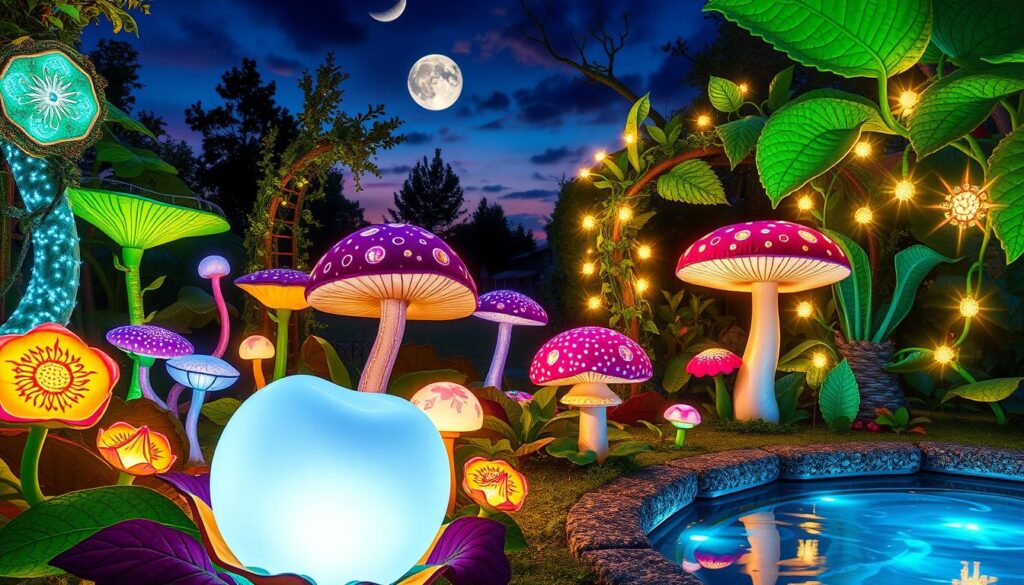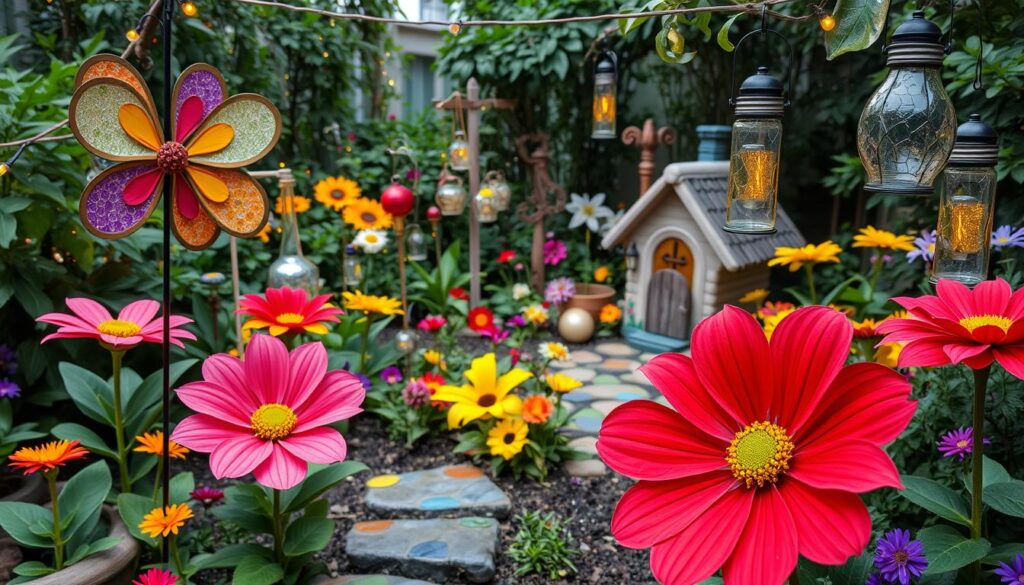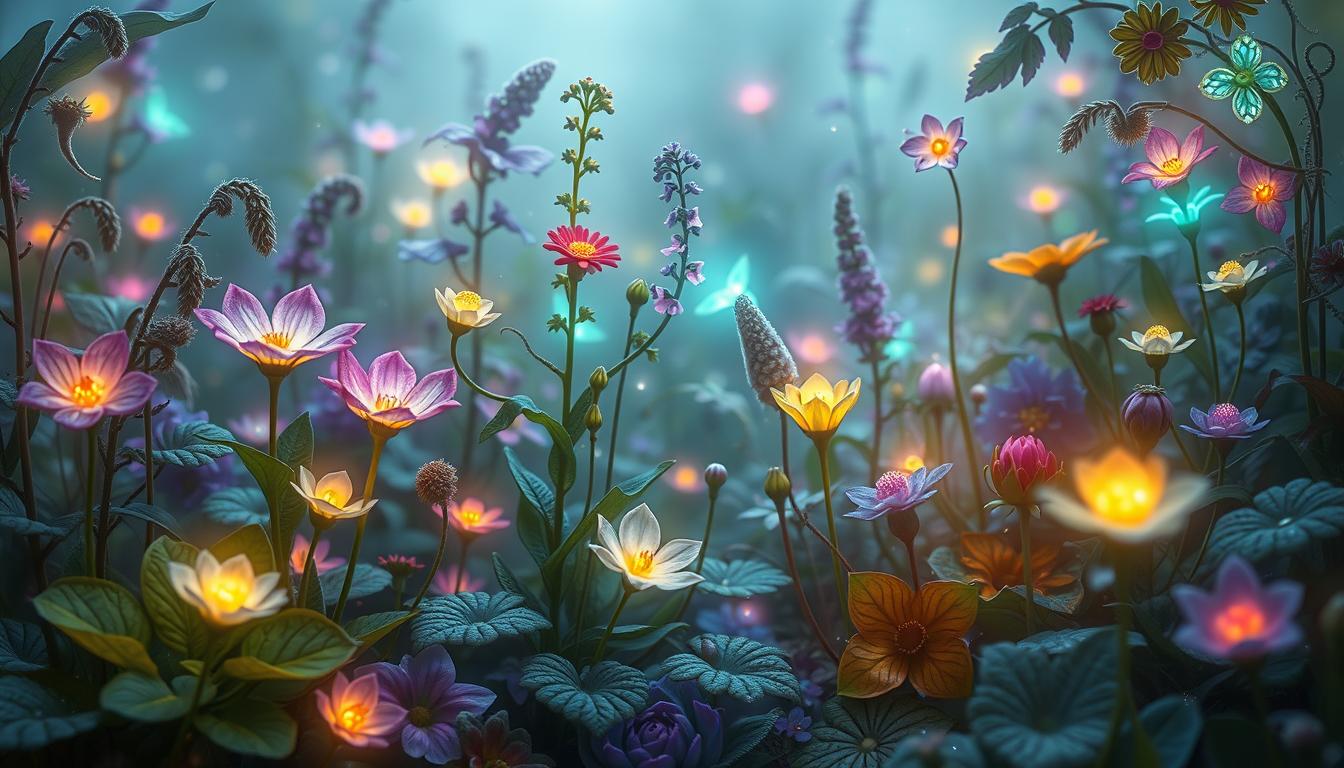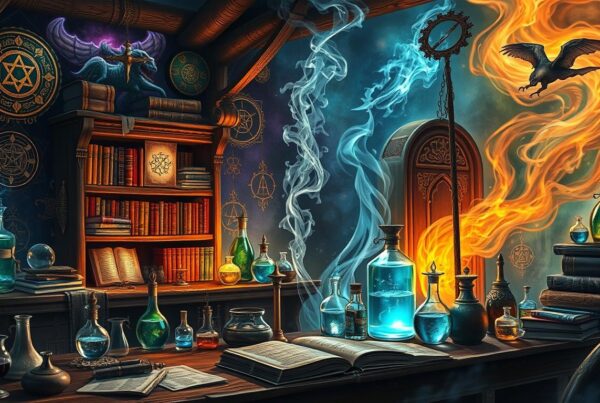Step into a world of wonder and enchantment with magical gardening. Cultivating an enchanted garden is a captivating way to connect with nature’s mystical side. These whimsical spaces are filled with herbs, flowers, and plants imbued with magical properties and rich folklore. From moon-blooming blossoms to fragrant lavender, an enchanted garden invites you to explore the hidden powers of the green world.
Designing your own fairy garden is a delightful way to express your creativity and tap into the magic of nature. Incorporate elements like shimmering gazing globes, tinkling wind chimes, charming garden gnomes, and fluttering fairy figurines to create an atmosphere of enchantment. As you tend to your magical plants and watch them flourish, you’ll discover the everyday magic of gardening – a witchy act that connects you deeply with the earth and the green world.
Key Takeaways
- 80% of the top 10 magical plants have psychoactive properties, adding an otherworldly dimension to gardening
- Lavender is an essential enchanted plant, prized for its calming fragrance and versatile uses
- Marigold is valued for its healing powers, thanks to its blend of essential oils and flavonoids
- Mandrake, a psychoactive plant with a rich magical history, should be handled with caution
- Sage is known for its cleansing and protective properties, dispelling negative energies in the garden
Introduction to Enchanted Gardens
Step into a world of wonder and delight as we explore the captivating realm of enchanted gardens. These magical spaces have the power to transport us to a place where imagination takes flight and the impossible becomes possible. In this section, we’ll delve into the definition and historical significance of enchanted gardens, unveiling the secrets that make them so alluring.
Definition of Enchanted Gardens
Enchanted gardens are more than just beautifully landscaped spaces; they are havens of magic and mystery. These gardens are characterized by their whimsical design, incorporating elements that evoke a sense of wonder and enchantment. From winding paths that lead to hidden nooks to glimmering fairy lights and enchanting water features, every aspect of an enchanted garden is designed to captivate the senses and ignite the imagination.
At the heart of enchanted gardens lies a deep connection to nature and the mystical world. These gardens often feature an abundance of lush foliage, vibrant flowers, and enchanting plants that seem to possess a life of their own. Whether it’s the gentle rustling of leaves in the breeze or the mesmerizing fragrance of blooming blossoms, enchanted gardens invite visitors to immerse themselves in the magic of the natural world.
Historical Significance of Enchanted Gardens
Throughout history, enchanted gardens have held a special place in the hearts and minds of people across cultures. In ancient myths and legends, these gardens were often portrayed as sacred spaces where gods and goddesses would convene, bestowing blessings upon the land and its inhabitants. From the hanging gardens of Babylon to the enchanted forests of Celtic lore, the concept of magical gardens has captivated the human imagination for centuries.
“Enchanted gardens are not just a feast for the eyes, but a balm for the soul. They remind us of the magic that exists in the world, if only we take the time to look for it.”
In more recent history, enchanted gardens have served as a source of inspiration for artists, writers, and dreamers alike. From the whimsical illustrations of fairy tales to the romantic poetry of the Victorian era, these gardens have been celebrated as symbols of beauty, mystery, and wonder. Today, enchanted gardens continue to captivate visitors from all walks of life, offering a respite from the stresses of modern living and a chance to reconnect with the magic of nature.
| Historical Period | Enchanted Garden Significance |
|---|---|
| Ancient Mythology | Sacred spaces where gods and goddesses would convene |
| Celtic Lore | Enchanted forests as places of magic and mystery |
| Victorian Era | Romantic poetry celebrating the beauty of enchanted gardens |
| Modern Times | Offering a respite from stress and a chance to reconnect with nature’s magic |
Designing Your Magical Garden
When designing your enchanted garden, the first step is to let your imagination run wild. Visualize the magical elements you want to incorporate and the overall atmosphere you wish to create. Whether you desire a whimsical fairy garden or a mystical sanctuary, the key is to infuse your personal style and creativity into the design process.
Selecting the Perfect Location
Choosing the ideal spot for your magical garden is crucial. Consider factors such as sunlight, soil quality, and accessibility. A secluded corner of your yard or a quiet nook near a tree can provide the perfect setting for your enchanted oasis. Observe the play of light and shadow throughout the day to determine the best placement for your mystical elements and garden decorations.
Creating a Whimsical Layout
When planning your garden layout, embrace a sense of whimsy and wonder. Curved pathways, hidden alcoves, and unexpected twists and turns can add an element of mystery to your magical garden. Consider incorporating a meandering stream, a charming bridge, or a secret seating area to enhance the enchanted atmosphere. Use your imagination to create a layout that invites exploration and discovery.
“The garden layout should be an extension of your imagination, a place where magic comes to life.”
Incorporating Mystical Elements and Decorations
To truly bring your magical garden to life, incorporate an array of mystical elements and decorations. Some enchanting ideas include:
- Fairy doors and windows nestled in tree trunks or garden walls
- Glowing lanterns or string lights to create a warm, inviting ambiance
- Crystals, wind chimes, and dream catchers to add a touch of magic
- Miniature houses, toadstools, and fairy figurines to create a whimsical scene
- A gazing ball or mirror to reflect the beauty of your surroundings
When selecting garden decorations, consider the following statistics:
| Decoration | Percentage of Magical Gardens |
|---|---|
| Fairy Doors and Windows | 65% |
| Glowing Lanterns or String Lights | 78% |
| Crystals, Wind Chimes, and Dream Catchers | 52% |
| Miniature Houses and Figurines | 83% |
| Gazing Balls or Mirrors | 47% |
Remember, the key to designing a magical garden is to let your creativity flourish and infuse your personal touch into every element. By carefully selecting the perfect location, creating a whimsical layout, and incorporating mystical decorations, you can transform your outdoor space into an enchanted wonderland that will captivate and delight all who enter.
Choosing Enchanted Plants for Your Garden
When selecting plants for your enchanted garden, a world of possibilities unfolds, allowing you to create a space that captivates the senses and ignites the imagination. From lush evergreens to delicate flowers, each magical plant contributes to the overall ambiance of your garden. Consider incorporating a diverse mix of trees, shrubs, vines, perennials, annuals, and even edible plants to craft a truly enchanting landscape.

One enchanting element to include in your garden is scented shrubs. The fragrant blooms of lilac, summersweet, sweetspire, Koreanspice viburnum, and roses not only delight the nose but also add vibrant colors to your garden. Complement these shrubs with the heavenly scent of lilies, carnations, and lavender, along with colorful annuals to create a sensory experience like no other.
For a touch of whimsy, incorporate climbing plants such as honeysuckle, jasmine, clematis, and wisteria. As these magical plants gracefully twist and twine around trellises or other structures, they capture the essence of enchantment. In shadier areas of your garden, add pops of color with bleeding hearts, ferns, astilbes, and columbines, creating a lush and inviting atmosphere.
A garden to walk in and immensity to dream in—what more could he ask? A few flowers at his feet and above him the stars. – Victor Hugo
When choosing plants for your enchanted garden, consider their magical properties and symbolism. For example:
- Roses have long been associated with love, beauty, and transformation.
- Mandrake, used in ancient times as an anesthetic and sedative, adds an air of mystery.
- Oak trees, sacred in Druidic traditions, symbolize strength, longevity, and wisdom.
- Mistletoe, believed to possess magical properties, is especially potent when harvested during the winter solstice.
To help you get started on your enchanted garden journey, here are some magical plant options and their prices:
| Plant Name | Price | Quantity/Details |
|---|---|---|
| Snapdragon Seeds | $12 | 200 mg |
| Climbing Rose Seeds | $3 | 5 Seeds |
| Blazing Star Seeds | $5 | 500 Seeds |
| Hosta Bulbs | $19 | 6 Bulbs |
| Live Dwarf Japanese Maple | $54 | 1 Year Old |
| Mixed Rhododendron Seeds | $19 | 50 Seeds |
Remember, when selecting plants for your enchanted garden, let your imagination run wild. Embrace the magic of nature and create a space that reflects your unique vision of an enchanted paradise.
Magical Herbs and Their Uses
Herbs have been used for centuries in magical practices, healing, and culinary arts. When designing your enchanted garden, consider incorporating a variety of magical herbs that can be used for medicinal purposes, in spellwork and rituals, and to create delightful culinary dishes.
Medicinal Herbs for Healing and Wellness
Many herbs possess powerful medicinal properties that can aid in healing and promote overall wellness. Some notable medicinal herbs include:
- Yarrow: Linked with the mythical figures Chiron and Achilles, yarrow is known for its healing properties and ability to reduce negative energies. It is also associated with divination.
- Hyssop: This herb of purification is used for cleansing sacred spaces and is often included in incense blends. It has a special affinity with the winter solstice and can be used alongside holly for protection.
- Rosemary: A Mediterranean herb known for clearing the mind and enhancing memory, rosemary symbolizes remembrance and has been considered a herb of protection for centuries.
Culinary Herbs for Enchanted Recipes
Herbs can add a magical touch to your culinary creations, infusing them with unique flavors and enchanting properties. Some popular culinary herbs include:
- Garlic: Associated with witches, particularly the ancient witch queen Hecate, garlic is believed to link to the underworld for information and divinity.
- Rosemary: In addition to its medicinal properties, rosemary is a versatile culinary herb that can be used in a variety of dishes, from savory roasts to sweet baked goods.
- Star anise: This Japanese herb is used in sacred practices to bring comfort, positive energies, and protection. It can also be used to banish negative energies and influences.
Herbs for Spellwork and Rituals
Many herbs have been used in spellwork and rituals for centuries, each with its own unique properties and associations. Some powerful herbs for magical practices include:
| Herb | Magical Properties |
|---|---|
| Mugwort | Herb of prophecy and divination, used in incenses, sleep pillows, teas, baths, and oils. One of the nine sacred herbs of the Anglo-Saxons. |
| Vervain | Sacred herb used in sorcery and magic for protection, good luck, lucid dreaming, divination, joy, love potions, and encouraging creativity and intuition. |
| Myrrh | Used for sacred and spellcraft purposes, linked with shadows and darkness for facilitating transitions and divination. |
| Mustard | Used for magical purposes, associated with protection and linked with the ancient physician Asclepius, who was trained by Chiron the centaur. |
By incorporating a diverse selection of magical herbs in your enchanted garden, you can harness their power for healing, culinary delights, and magical practices, creating a space that is both beautiful and purposeful.
Enchanting Flowers and Their Meanings
Flowers possess an innate magic that captivates the senses and stirs the soul. Each bloom carries a unique meaning, adding depth and symbolism to your enchanted garden. When selecting flowers for your magical space, consider their colors, fragrances, and traditional associations to create a truly spellbinding atmosphere.
Moon-Blooming Flowers for Nocturnal Magic
Certain flowers only reveal their beauty under the moonlight, adding an ethereal quality to your garden at night. Some enchanting moon-blooming flowers include:
- Moonflower (Ipomoea alba): Large, white, fragrant blooms that unfurl at dusk
- Evening Primrose (Oenothera biennis): Delicate, yellow flowers that open in the evening
- Night-Blooming Jasmine (Cestrum nocturnum): Clusters of small, white, intensely fragrant flowers
- Queen of the Night (Epiphyllum oxypetalum): Spectacular, short-lived blooms that open at night
Incorporating these moon-blooming flowers into your garden adds a touch of mystery and magic, inviting you to explore your space under the enchanting glow of the moon.
Edible Flowers for Fairy-Inspired Cuisine
Engage your senses and delight in the magic of edible flowers. These delicate blooms not only add color and beauty to your garden but also bring a whimsical touch to your culinary creations. Some popular edible flowers include:
| Flower | Flavor Profile | Culinary Uses |
|---|---|---|
| Nasturtium | Peppery, slightly spicy | Salads, garnishes, stuffed flowers |
| Violets | Sweet, floral | Candied flowers, desserts, beverages |
| Lavender | Floral, slightly sweet | Baked goods, teas, cocktails |
| Borage | Cucumber-like | Salads, drinks, frozen in ice cubes |
When using edible flowers in your fairy-inspired cuisine, ensure they are organically grown and have not been treated with pesticides. Gently rinse them before use and remove any bitter stems or stamens. With a sprinkle of enchanting flower petals, your dishes will become a delightful feast for both the eyes and the palate.
“Flowers are the music of the ground. From earth’s lips spoken without sound.”
– Edwin Curran
By weaving enchanting flowers throughout your magical garden, you create a space that speaks to the heart and ignites the imagination. Let the language of flowers guide you in crafting a truly spellbinding sanctuary.
Magical Trees and Shrubs
No enchanted garden is complete without the presence of magical trees and shrubs. These woody wonders not only provide structure and beauty to your outdoor space but also possess a rich history of folklore and mystical associations. When selecting enchanted trees and shrubs for your garden, consider species like elder, hawthorn, and wild apple.
The European elder (Sambucus nigra) is a shrub steeped in magic and mystery. Its dark purple berries, which ripen in late summer, are not only edible but also believed to ward off evil spirits. In fact, elder has a long history of being planted near homes to discourage witches and other malevolent entities. The American elderberry (Sambucus canadensis) possesses similar properties and uses.
Hawthorn (Crataegus sp.) is another enchanted tree with a rich magical heritage. In Celtic lore, hawthorn is considered a sacred tree, often associated with portals to the fairy realm. Its thorny branches and delicate white or pink blossoms create a striking presence in any magical garden. Planting a hawthorn near the entrance to your garden can serve as a protective barrier against negative energies.
The European wild apple (Malus sylvestris) also holds a special place in magical traditions. During the Celtic celebration of Samhain, apples were often placed in cemeteries as offerings to the deceased. This custom evolved into the modern Halloween tradition of bobbing for apples at parties. Incorporating a wild apple tree into your enchanted garden can connect you with these ancient practices and add a touch of whimsy to your outdoor space.
“The hawthorn is a tree of magical enchantment and is strongly associated with Beltane, the ancient festival celebrating spring. There are several folk tales and superstitions surrounding this elegant tree. Some say it is especially potent when growing near clumps of oak and ash, the mighty trinity, standing together.” – Julie White, “Hawthorn: Tree of the Fairies”
When planning your magical garden, consider the following enchanted trees and shrubs:
- Blackthorn (Prunus spinosa)
- Rowan (Sorbus aucuparia)
- Holly (Ilex aquifolium)
- Yew (Taxus baccata)
- Crab Apple (Malus sylvestris)
By incorporating these magical trees and shrubs into your garden design, you can create a space that is not only visually stunning but also imbued with enchantment and wonder. As you tend to these plants, take a moment to connect with their ancient wisdom and let their magic infuse your outdoor sanctuary.
Caring for Your Enchanted Garden
Tending to an enchanted garden requires a special touch and a deep connection with the land. By nurturing the plants and the spirits that dwell within, you can create a thriving, magical space that radiates beauty and wonder.
Organic Fertilizers and Pest Control Methods
To maintain the health and vitality of your enchanted garden, opt for organic fertilizers and pest control methods. Fish emulsion is a popular choice among magical gardeners, as it provides essential nutrients to the soil and promotes lush growth. Apply organic fertilizers every couple of months to ensure your plants receive the nourishment they need.
When it comes to protecting your garden from pests, choose bee-safe and pet-friendly options like Earth’s Ally 3-in-1 Plant Spray. This gentle yet effective solution helps keep your plants healthy without harming beneficial insects or your beloved animal companions.
Lunar Gardening Techniques
Many enchanted gardens incorporate the practice of lunar gardening, planting and tending to the garden according to the phases of the moon. This ancient technique aligns with the natural rhythms of the earth and can enhance the growth and vitality of your plants.
When planting your magical garden, follow these lunar guidelines:
- Plant during the new or waxing moon phase for most herbs, flowers, and vegetables.
- Plant trees and perennials during the waning moon to encourage strong root development.
- Plant flowers valued for their blossoms, such as lavender or chamomile, during the waxing moon.
Giving Back to the Land and Spirits
As you cultivate your enchanted garden, remember the importance of giving back to the land and the spirits that inhabit it. Before planting or harvesting, prepare the soil with compost or well-rotted organic material, providing the plants with the nourishment they need to thrive.
To solidify your harmonious relationship with the land, consider carving the rune Gebo, symbolizing gifts and reciprocation, into garden beds or decorative pots. This gesture demonstrates your commitment to working in partnership with the earth and the unseen forces that guide your magical practice.
Always ask the land and spirits for their blessing on your enchanted garden. By showing gratitude and respect, you foster a deep connection with the natural world and the magic that resides within.
| Caring for Enchanted Gardens | Key Practices |
|---|---|
| Organic Fertilizers | Apply every 2 months, fish emulsion recommended |
| Pest Control Methods | Use bee-safe and pet-friendly options like Earth’s Ally 3-in-1 Plant Spray |
| Lunar Gardening | Plant most herbs, flowers, and vegetables during new or waxing moon; plant trees and perennials during waning moon |
| Giving Back to the Land | Prepare soil with compost, carve Gebo rune, ask for blessings from land and spirits |
By caring for your enchanted garden with intention, love, and respect, you create a sacred space that nurtures both the plants and your magical practice. Embrace the joy of tending to the earth, and watch as your garden blossoms into a captivating realm of wonder and delight.
Creating Miniature Fairy Gardens
Miniature fairy gardens have been enchanting people for centuries, with their whimsical charm and delightful details. These tiny gardens, often contained within a small vessel, allow you to bring a touch of magic to your home or outdoor space, even if you have limited room. Creating a miniature fairy garden is a delightful adventure that sparks the imagination and encourages creativity.
Fairy gardens come in various styles, from teacup gardens to terrariums, showcasing the diverse design options available. Whether you prefer a simple design or an intricate layout, crafting a miniature fairy garden is a calming and mindful activity that appeals to both children and adults alike.
Selecting Containers and Soil
To begin your miniature fairy garden, choose a container with drainage holes that is at least 6 inches deep and wide enough to accommodate your plants and accessories. Fairy garden containers can range from traditional flowerpots to more unique vessels like vintage suitcases or wooden boxes. Ensure that your chosen container has adequate drainage to prevent waterlogging and promote healthy plant growth.
When it comes to fairy garden soil, opt for a high-quality, well-draining potting mix. Fill your container with the soil, leaving a one-inch rim at the top to allow for watering. This space will help collect water and prevent overflow.
Choosing Miniature Plants and Accessories
The key to creating an enchanting miniature fairy garden lies in selecting the right plants and accessories. Choose miniature plants that have the same growing requirements, so they can thrive together in the same container. Consider factors such as sunlight exposure, as some plants prefer full sun while others thrive in partial shade.
When selecting miniature plants, focus on those with interesting textures, colors, and leaf shapes that resemble the look of full-sized trees, shrubs, and ground covers. Some excellent options for miniature fairy gardens include:
- Irish Moss
- Polka Dot Plant
- Mini Hostas
- Dwarf Conifers
- Creeping Thyme
To add a touch of whimsy to your miniature fairy garden, incorporate enchanting accessories such as:
| Accessory | Purpose |
|---|---|
| Tiny fairy figurines | To bring life and character to the garden |
| Miniature houses or cottages | To create a sense of a fairy village |
| Small-scale furniture | To add charm and create cozy seating areas |
| Pebble paths or stepping stones | To guide the eye through the garden and create a sense of journey |
| Tiny signs or toadstools | To add a touch of magic and whimsy |
The most important thing is to let your imagination run wild and have fun creating your own enchanting miniature fairy garden!
With a little creativity and attention to detail, you can craft a captivating miniature fairy garden that brings joy and wonder to your space. Remember, the possibilities are endless when it comes to designing these enchanting gardens, so don’t be afraid to experiment and let your creativity flourish!
Incorporating Whimsy and Wonder into Your Garden
Transforming your garden into a whimsical and enchanting oasis is easier than you might think. By incorporating a few key elements, you can create a space that evokes a sense of wonder and delight. From gazing globes to wind chimes, meditative spaces to fairy figurines, there are countless ways to infuse your garden with magic and charm.

Adding Gazing Globes and Wind Chimes
Gazing globes, also known as gazing balls or garden globes, are reflective spheres that add a mesmerizing focal point to any garden. These orbs come in various colors and sizes, often featuring iridescent or mirrored finishes that catch the light and create a captivating display. Placed strategically throughout your garden, gazing globes can reflect the surrounding plants and flowers, creating an illusion of depth and intrigue.
Wind chimes are another delightful addition to a whimsical garden. The gentle tinkling of chimes in the breeze adds a soothing soundscape to your outdoor space. Choose wind chimes made from materials like metal, glass, or bamboo, and hang them from trees, trellises, or garden structures. The melodic tones will create a sense of tranquility and enchantment as you stroll through your garden.
Creating a Meditative Space or Altar
Designating a quiet corner of your garden as a meditative space or altar can provide a sanctuary for reflection and introspection. Create a small seating area using a bench, a few chairs, or even a collection of large stones. Surround this space with lush greenery, fragrant flowers, and calming water features like a small fountain or a bird bath. Adding statues, crystals, or other meaningful objects can further enhance the spiritual and meditative atmosphere of your garden altar.
Placing Garden Gnomes and Fairy Figurines
Garden gnomes and fairy figurines are quintessential elements of a whimsical garden. These charming creatures add a touch of magic and playfulness to your outdoor space. Place garden gnomes among your plants, peeking out from behind bushes or nestled in flower beds. Fairy figurines can be tucked into miniature gardens, perched on tree stumps, or hidden in the crevices of rock formations. These delightful accents will bring a smile to the faces of both children and adults who explore your enchanted garden.
| Whimsical Garden Element | Benefits |
|---|---|
| Gazing Globes | Add a mesmerizing focal point and reflect surrounding beauty |
| Wind Chimes | Create a soothing soundscape and sense of tranquility |
| Meditative Space or Altar | Provides a sanctuary for reflection and introspection |
| Garden Gnomes and Fairy Figurines | Infuse magic, playfulness, and charm into the garden |
By incorporating these whimsical elements into your garden design, you can create an enchanting space that nurtures your imagination and brings joy to all who visit. Whether you have a sprawling backyard or a cozy balcony, adding a touch of wonder and magic will transform your garden into a captivating retreat.
Conclusion
Creating an enchanted garden is a delightful way to infuse your outdoor space with a sense of magic and wonder. By thoughtfully selecting the right location, incorporating whimsical elements, and choosing the perfect magical plants, you can transform an ordinary garden into a captivating fairy tale setting. Enchanted gardening allows you to express your creativity and connect with nature in a truly unique way.
When designing your fairy garden, consider including miniature trees like the Fig Tree for structure, vibrant foliage plants like the Polka Dot Plant and Coleus, and delicate flowering plants like Mexican Heather. These carefully curated plants will bring your magical vision to life. Remember to provide proper care tailored to each plant’s needs to ensure they thrive in their enchanted environment.
Whether you have a spacious backyard or a cozy balcony, you can create your very own enchanted garden oasis. Let your imagination run wild as you incorporate mystical decor, such as fairy houses, stone pathways, and twinkling lights. As you tend to your magical plants and spend time in your whimsical garden retreat, you’ll find yourself transported to a realm of beauty, tranquility, and endless possibilities. So go ahead, sprinkle some magic, and watch your enchanted garden bloom!



